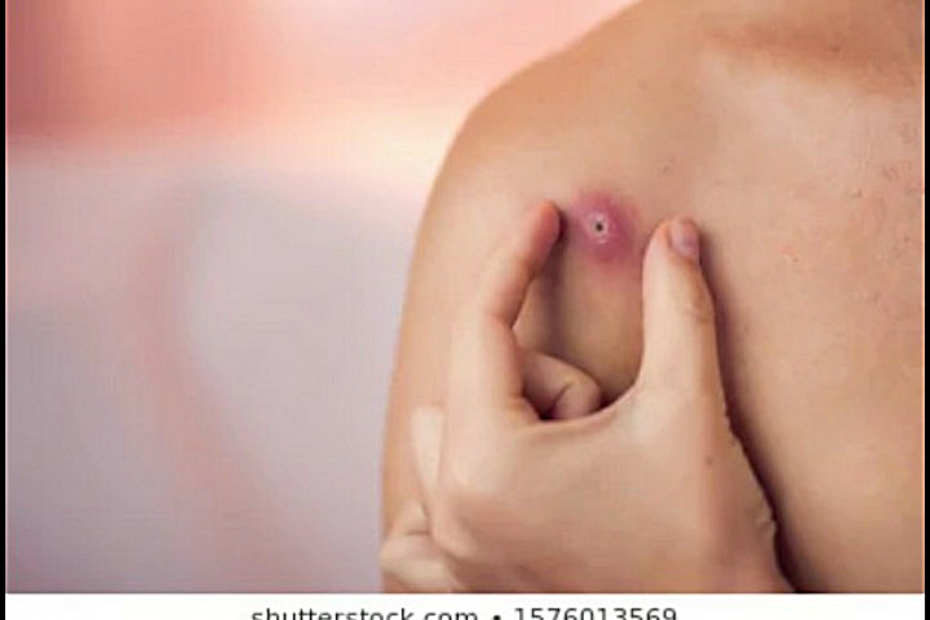Boils also known as furuncles are common skin infections, they are usually painful and can affect our daily activities depending on where they form. They can form on hair containing skin anywhere on the body like the face, armpits, groin, buttocks, back, eyelids, nose, and other areas.
Boils usually begins in a hair follicle and present as a reddened tender lump. After about 3-5 days, the lump becomes filled with pus which contains dead white blood cells, dead bacteria and destroyed tissue. This forms because the body is trying to eradicate the bacteria causing the boil. The boil can develop an opening from which pus drains out on its own or an opening can be surgically created.
It can be treated at home but when a boil develops in a sensitive area or becomes resistant to treatment, medical attention is required.
Some related conditions include the following:
- Skin abscess occurs when significant amount of pus collects in the tissues under the skin.
- Carbuncles are a collection of several boils or furuncles that occur close to each other. It is usually more serious than a single furuncle and more frequently leads to abscess formation.
CAUSES OF BOILS
Most boils are caused by a bacterium that is commonly found on our skin and in our nostrils: Staphylococcus aureus. The bacteria is not harmful when on the skin, but when it enters the skin through cuts or tiny breaks on the skin, it becomes harmful causing boils.
Other causes include the presence of a foreign material in the skin; plugged sweat glands; ingrown hair or nails that become infected.
TREATMENT OF BOILS AT HOME
Home treatment involves applying warm compresses on the boil surface at least three times daily for about 10minutes each time. Warm compress increases blood flow to the area and hence increases the supply of white blood cells and antibodies to the area of the boil. This makes the body fight off the bacteria causing the boil at a faster rate.
If a boil develops due to regular shaving, it is advisable to stop shaving that area until the boil has healed.
Resist the urge to continually pick on; squeeze or pop the boil while it is still small and hard. The bacteria causing the boil can spread and cause more boils to form around the area of the original boil.
Warm compress can make the boil become soft faster and enable it drain out on its own.
Wash your hands after cleaning the boil surface to prevent its spread.
WHEN TO SEE A DOCTOR
Normally, boils heal on their own after home care. However, you need medical attention if:
- The boil lasts for a more than a week after home care
- There is an underlying condition like diabetes
- The boil keeps reoccurring after treatment.
- The boil forms on a sensitive area of the body like the eyelids, neck, nose, forehead, and joints.
- The boil causes fever and chills.
- The boil is large and painful
- Large boils are opened and drained by a doctor making an incision on it. After draining the boil, the incised cut is wrapped in a sterile gauze which is changed regularly to prevent contamination.
- The doctor may prescribe some antibiotics to help the boil heal faster and prevent contamination of the incised boil.
PREVENTION OF BOIL
Boils can affect anyone at any time, so we need to stay healthy and avoid getting boils frequently by carrying out the following measures:
- Proper personal hygiene.
- Properly treat and cover minor cuts and injuries to prevent infection.
- Avoid sharing towels and personal items with other people.
- Use of sponge and soap during baths can help break up oil buildup and clogs around hair follicles
- Avoid shaving, touching, pinching, or pressing around a boil to avoid its spread.

Ezike Nonye is a Pharmacist who completed her Bachelor degree from University of Lagos (B.Pharm). She is currently exploring digital marketing analytics as a novel field in Pharmacy practice while also interning at the Federal Medical Center (FMC) Abeokuta, Ogun State, Nigeria. She is a graphic designer, a blogger and an entrepreneur. She is passionate about creating new things from nature and believes that there is no limitation to what you can achieve. She is a Christian and loves writing and open to new ideas and skills.

